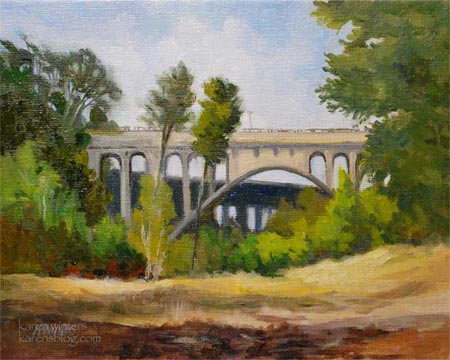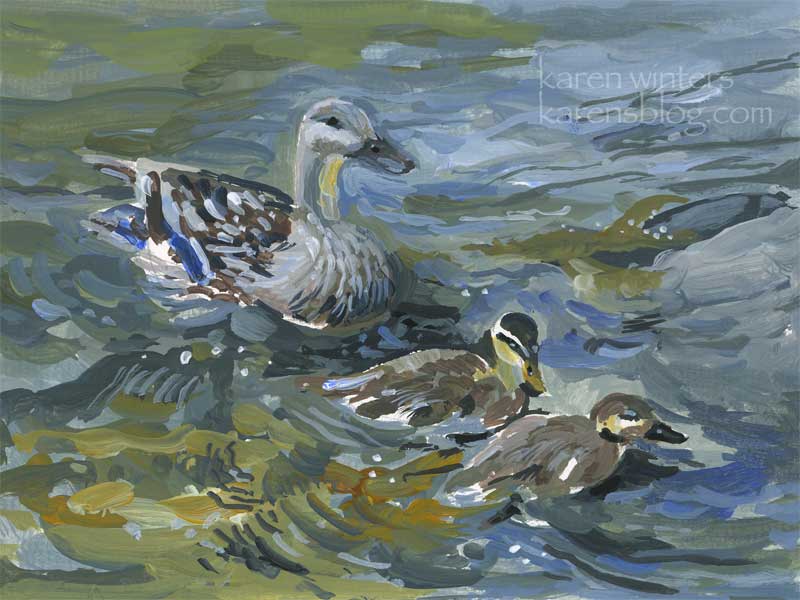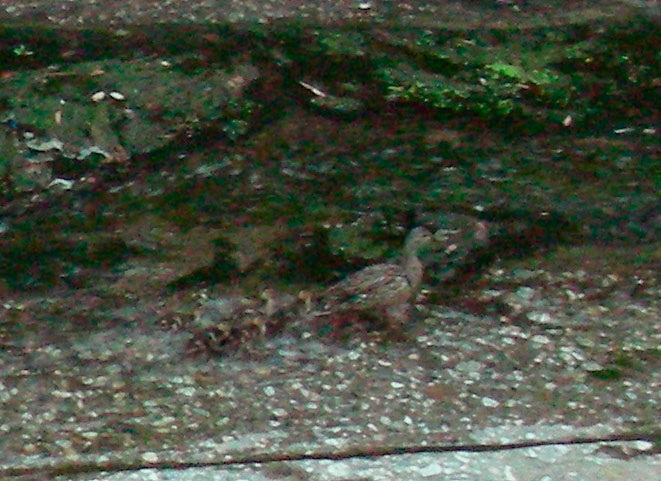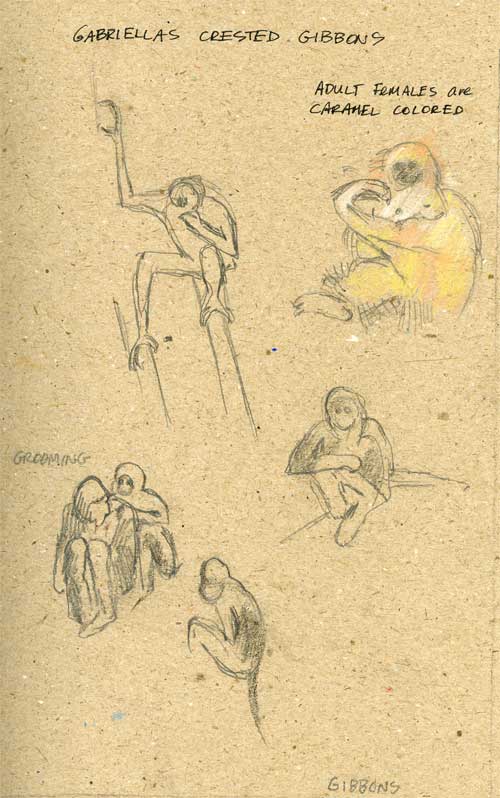Colorado Street Bridge – Summer Landscape California Oil Painting
Pasadena Bridge – Summer Days
(Colorado Street Bridge)
8 x 10 oil on canvas
SOLD but I have other bridge paintings
This California landscape is one that is familiar to residents of Pasadena and the communities surrounding the Arroyo Seco. The Colorado Street Bridge , seen here looking northward, rises over the grassy fields that are now turning golden. Only the evergreen eucalyptus, oaks, willows and other natives keep their colors. The 134 freeway bridge can be seen in the distance. On these late spring days it’s not uncommon to see thunderheads building over the San Gabriel Mountains – you can feel the humidity build up at those times.
I am counting down the days until my reception at Gale’s Restaurant in Pasadena. Sunday, May 31, 4-6 pm. If you’re local, I hope you can come!
Book tip of the day: Kevin McPherson’s Landscape Painting Inside and Out: Capture the Vitality of Outdoor Painting in Your Studio With Oils. I do plein air painting as often as I can … but I have learned a lot from this book and others about keeping the fresh plein air feeling while painting in studio. Check it out!
The Ducklings and the Dam: An Art Fable
“Duck and ducklings” 6 x 8 acrylic on matboard
SOLD
On Saturday afternoon, just before sunset, my husband and son and I decided to take a walk in the Arroyo Seco area of Pasadena, which is spanned by several enormous bridges. A river runs through it, although this time of year it is usually a trickle. The river comes out of Hahamongna Park, another area that I like to go to paint and draw.
Having left the parking lot, we were heading toward the bridges when both my husband and I spied something extraordinary down in the flood channel: a mother duck was leading her five ducklings upstream. The channel, paved with cement, was mostly dry, but the area where they were walking (and they were walking, not paddling) was damp and slick with algae. The mother kept a brisk pace and the ducklings ran their little buns off trying to keep up with her. Where did they come from? How did they get down into the channel with its vertical sides which they clearly couldn’t get out of?
I was not concerned about them drowning. They are ducks after all and even if the meager flow in the channel increased, they could simply float on top of it. But I was worried about one hazard that lay ahead; a steep 45 degree ramp that formed the dam’s spillway that held back the upper pond. If they could not get out of the channel, the group would be easy picking for predators (such as owls) and night was approaching rapidly.
We gave up our desire for an aerobic walk and paced the ducks as they continued their trek. At times some of the smaller ones would take a tumble, but they quickly regained their footing and put on the speed to catch up with the group. The mother did not hesitate nor look back but would occasionally issue sharp quacks which I took to be a sort of encouragement to keep up. She set the pace and their imprinting forced them to follow.
Soon the steep ramp loomed ahead. We crossed a bridge and continued watching them as they approached this obstacle. We wondered how they would fare and held our breath. My husband was already assessing the situation and figuring a way down into the channel in case he had to do a rescue operation. That’s just the kind of man he is – always at the ready to help a damsel in distress.
The mother duck bravely led her charges up the ramp, avoiding the slick area and keeping to patches of dry paving. Her children struggled behind her but kept up the pace. But there was a final obstacle – a small protruding ledge, jutting out no more than 3 or 4 inches that they would have to go around. It was this ledge that had kept the slope dry for their ascent, but going around it and entering the pool of water at the top would mean stepping into a slippery stream of slime. We could practically see her assessing the situation and she opted to go around the corner of the ledge, her babies following. The safety of the pool was only a foot away, but the steep slippery slope was too great a match and she tumbled far down the slope, sweeping the ducklings with her. As soon as she recovered from the fall she turned around and headed back up the dry area again, and the ducklings followed. Thankfully, none seemed injured in the fall. As she approached the barrier ledge, this time she fluttered her wings and hopped over it. She was safe … but what about her brood?
The mother duck turned around and issued a few sharp quacks and the babies, unable to fly enough to get over the ledge, went around the ledge as they had before, but with their lighter mass and without the mother falling and carrying them down, four were able to scramble through the slippery scum and just barely get a webbed foothold on the top ledge, to join the other in the waiting pond.
The fifth duckling was not so fortunate and tumbled down the slope a second time. We were surprised to see that the mother duck was not anxiously looking over the ledge to see what happened to the final one. She had four to keep track of on top. Nature, or instinct probably told her to look after the greatest number. The fifth duckling shook itself off again, and with inspiring determination trudged up the slope a third time, got to the most treacherous part, fluttered and made it over the top to join the family. We, and some other walkers watching this episode all broke out in applause. The duck then quickly shepherded all the ducklings under some willow trees that were overhanging the pond. This, no doubt, would be their safe haven for the night. We saw her later diving for food in the pond, but the babes were nowhere to be seen.
Questions arose that we will never have answers for. Had the family been nesting elsewhere and just decided to relocate? Or were they always living in the upper pond and the mother had taken them all out for exercise and strengthening. Had she been a duck raised in that area or was she from somewhere else? Where was the drake? Was she unconcerned about the fate of the fifth duckling when she turned her attention to the others? Was she obeying an instinct that told her to keep her eye on the greatest number? Or did she have faith that the last little one would make it?
And what, if anything, does all of this have to do with making art?
Here’s what I’ve learned from these duck adventures:
1. Getting where you want to go isn’t always easy and it isn’t always fun. It can be a lot of hard work just trying to keep up. But whining and falling behind really isn’t an option.
2. When you’re on a journey (creative or otherwise) it’s good to have companions to help you keep the pace. Make friends with other artists and take part in activities that challenge you. “Play up” as they say in sports. Do things with people who are more skilled and experienced than you are. Be inspired by their determination and energy.
3. Find a good mentor who knows the way and who will lead by example. The mother duck didn’t try to carry the babies on her back or worry about whether they were all comfortable and having a good time. (“Are we there yet?”) She set the pace and the expectations. She didn’t nag, cajole or make snarky comments about their paddling technique. A few directive quacks seemed to be enough to keep the group in line. Imprinting and instinct did the rest.
4. Unexpected obstacles will arise. Take them in stride. Just when you think that your journey is going to be a walk in the park, you come upon a 45 degree wall of slime with only a small semi-dry pathway to the top. Try to avoid the slime if you can. And if you can’t …
5. Don’t let a setback (or two, or three) stop your journey. If you’re pushing yourself you will certainly face seemingly insurmountable problems. But the truth is, everyone trips. Everyone falls. Everyone makes a fluttering, crashing spectacle of themselves at one time or another. But those are learning experiences and the next time you face the obstacle you might just try something different or decide to gather yourself together and muscle your way through. If you’re a duckling, failure and giving up is not an option. Don’t make it an option for you, either. Even if you’re the fifth duckling and everyone else has “arrived”, keep going. You can all party and pig-out on polliwogs at the top.
6. Struggle makes you stronger. My guess is that those ducklings were going to sleep well Saturday night. But Sunday morning they’d be stronger and more experienced than if they hadn’t had that field trip. Maybe the mother duck knew that, too. If you avoid a certain type of drawing or painting, tackle it. Face the hill.
Below: The real mom and ducklings in the channel. Sorry it’s not a good picture but low light conditions, distance and shooting through a chain link fence complicated things
Gibbons
Yesterday we went to San Diego Wild Animal Park, and these are some quick sketches I did of some gibbons. Because they were in motion most of the time, there was not much opportunity for detail. A suggestion of posture and behavior was about all I got.
I’ll write more later when I scan some other sketches, but overall the place was a disappointment. A realistic habitat is fantastic for the animals and important for conservation, but when many of the animals are so far away that you can’t see them, it leaves a little bit to be desired. These gibbons were among the few that were close enough to a viewing area to be seen. If you wanted to get see the giraffes closer than the distance of a few football fields from a moving tram, you had to purchase a special pricey photo safari on top of your park admission. If you’d like to see a cheetah run (or see the cheetah at all, in fact) sorry, that’s another special event.
I know that the costs of admission go toward caring for the animals, but I felt that the park overpromised and under delivered. The commercial that showed how close you could get to see the lions only applied if the lions deigned to go up next to the plexiglass window. There were only two lions on display, perched on a hillside quite a distance away. I’ll try some drawing from photo references we took.
I’ll have more to say about the good parts later.
Approaching Storm
Much of the time I’m unsatisfied with the outcome of what I’m drawing or painting. I’m rarely unsatisfied with the process of practice and learning, just unsatisfied with the result. I think this is natural for a student of any age, and I consider myself a student.
However, every now and then I paint or draw something which I think shows progress in my study, and this digital study is one of those times. It’s subject is a bird, but thematically it’s about much more. As a minstrel poet of our times once wrote: “You don’t have to be a weatherman to know which way the wind blows.”
Art details: The crow and stump were painted freehand in Photoshop, using a photo as a reference. It is not a paint-over or a photo manipulation, nor do I trace. I start with a rough sketch, black on white, just like with a ‘real’ pencil or brush, and build up the layers with semi-transparent brushstrokes, bit by bit. The Photoshop file was opened in Corel Painter, where the background was painted on other layers using customized brushes. The whole thing was brought back into Photoshop for final color correction, watermark and jpegging. I am working on a non-digital version of this also which may be available for sale. For this digital study I used a small Wacom tablet that’s about 5 years old, nothing fancy.
Fast sketching pays off
And they say that being a sketcher has no practical application …
Caricaturist draws picture of the man who mugged him
Tracy Sugarman, WW2 veteran artist

World War II artist: Tracy Sugarman
If you’re like me, there’s nothing more interesting than peeking inside someone else’s journal or travel diary to see life through their eyes at a particular time and place. That’s why I’ve been getting so much enjoyment from Tracy Sugarman’s drawings and watercolors from the Library of Congress “Experiencing War” Veteran’s History Project, documented by the US Library of Congress.
You’ll find 85 drawings and paintings at that address which portray life in the Navy before, during and after D-Day. You’re going to want to spend some time there, and the pictures can be enlarged quite a bit to see detail. Sugarman served for three years and I believe he is still living as the website shows no date of death.
This one is particularly interesting because you can see how he did his underdrawing before applying paint.
Museum of Media History
Do you ever wonder where the confluence of news, personal datamining, online shopping and customization will take us?
Here’s one futuristic view … allow about 8 min for viewing.






